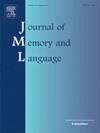Fluid intelligence correlates with working memory capacity for both real-world objects and simple-feature stimuli
IF 3
1区 心理学
Q1 LINGUISTICS
引用次数: 0
Abstract
Previous research has shown that individual differences in visual working memory performance strongly correlate with measures of fluid intelligence. In these studies, visual working memory was assessed using simple feature stimuli, such as oriented lines or colored squares, as traditionally done. However, recent studies have shown that working memory performance is higher for meaningful stimuli (i.e., real-world objects) relative to simple features. How does working memory capacity for real-world objects relate to fluid intelligence? To test this, participants (103 young adults) completed different visual working memory tasks that used images of real-world objects or simple colored circles as well as fluid and crystallized intelligence tests. The results showed reliable correlations between all working memory tasks and fluid intelligence scores, and no significant differences between these correlations across stimulus types. Interestingly, fluid intelligence scores were correlated with the difference in working memory performance between real-world objects and colored circles, suggesting that the increase in working memory capacity for meaningful stimuli relates to fluid intelligence abilities. Working memory performance was not reliably correlated with crystallized intelligence in any of the tasks. Collectively, these findings suggest that maintaining real-world objects and colored circles largely rely on shared cognitive processes that may, in part, underlie individual differences in fluid intelligence.
流体智力与现实世界物体和简单特征刺激的工作记忆能力有关
先前的研究表明,视觉工作记忆表现的个体差异与流体智力的测量密切相关。在这些研究中,视觉工作记忆是用简单的特征刺激来评估的,比如定向线或彩色方块,就像传统的方法一样。然而,最近的研究表明,相对于简单的特征,有意义的刺激(即现实世界的物体)的工作记忆表现更高。现实世界物体的工作记忆能力与流体智力有何关系?为了验证这一点,参与者(103名年轻人)完成了不同的视觉工作记忆任务,这些任务使用了现实世界物体的图像或简单的彩色圆圈,以及流体和结晶智力测试。结果显示,所有工作记忆任务与流体智力得分之间存在可靠的相关性,并且这些相关性在不同刺激类型之间没有显著差异。有趣的是,流体智力得分与现实世界物体和彩色圆圈之间的工作记忆表现差异相关,这表明对有意义刺激的工作记忆容量的增加与流体智力能力有关。在任何任务中,工作记忆的表现与结晶智力的关系都不可靠。总的来说,这些发现表明,保持现实世界的物体和彩色圆圈在很大程度上依赖于共同的认知过程,这可能在一定程度上是流体智力个体差异的基础。
本文章由计算机程序翻译,如有差异,请以英文原文为准。
求助全文
约1分钟内获得全文
求助全文
来源期刊
CiteScore
8.70
自引率
14.00%
发文量
49
审稿时长
12.7 weeks
期刊介绍:
Articles in the Journal of Memory and Language contribute to the formulation of scientific issues and theories in the areas of memory, language comprehension and production, and cognitive processes. Special emphasis is given to research articles that provide new theoretical insights based on a carefully laid empirical foundation. The journal generally favors articles that provide multiple experiments. In addition, significant theoretical papers without new experimental findings may be published.
The Journal of Memory and Language is a valuable tool for cognitive scientists, including psychologists, linguists, and others interested in memory and learning, language, reading, and speech.
Research Areas include:
• Topics that illuminate aspects of memory or language processing
• Linguistics
• Neuropsychology.

 求助内容:
求助内容: 应助结果提醒方式:
应助结果提醒方式:


